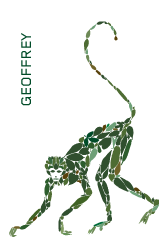This plant database was created by the Azuero Earth Project through the gathering of different lists of species that are known to grow or have been recommended to plant along the dry parts of Azuero. Biologists, foresters and other local experts of the flora of the Azuero created these lists while AEP staff put them together and investigated the characteristics of the listed species.
The dry forest ecosystem, defined by Román et al. (2013) have less than 1500 mm. of annual rainfall and a dry period that can last up to 7 months. In Panama, this is what is commonly called the “Arco Seco” or Dry Arc, an area that borders the Pacific Ocean and includes sections of Los Santos, Herrera and Coclé provinces on the Azuero Peninsula.
The plants characteristics in this database try to demonstrate easy and concise information that a person without technical knowledge of plants will be able to understand. The goal of this database is to help people select species to plant in the dry areas of the Azuero and to choose them by considering practical characteristics of the plants. The FAQ section of the Plant Database notes how the available plant information was categorized.
The addition of species and the new information of species currently in the database is an ongoing process. As new research is done and more of the uncommon species are planted, new information will be generated that can fill the current gaps.
Sources
The sources of information were sorted according to the local information of the Azuero they contained. The following sources, sorted by importance, were the main ones used in this database:
– Guía para la propagación de 120 especies de árboles nativos de Panamá y el Neotrópico (Román et al. 2013)
– Tree Atlas of Panama, by Rolando Perez and Richard Condit
– Trees of Panama and Costa Rica (Condit, Pérez & Daguerre. 2011)
– Arboles de Centroamérica (Cordero & Boshier. 2003)
– Árboles y Arbustos de Panamá (Carrasquilla. 2008)
– Plantas de uso folclórico y tradicional en Panamá (Chízmar, Lu & Correa. 2009)
– Plantas comestibles de Centroamérica (Chízmar, 2009)
– Arboles maderables de Costa Rica. Ecología y Silvicultura (Jiménez et al. 2011)
– Producción Forestal para América Tropical (Frank H. Wadsworth. USDA. 2000)
– Silvics of Native and Exotic Trees of Puerto Rico and the Caribbean Islands (Francis & Lowe. 2000)
– Red ProNativas
– Seashore Plants of South Florida and the Caribbean (Nellis. 1994)
People that have been involved in many of the reforestation projects in the Azuero also gave their input to the database. Restoration expert José Deago, forester Emilio Mariscal, Diogenes Ibarra owner of the local tree nursery in Pedasi, Jairo Batista part of the original reforestation project PRORENA, Horacio Peralta “Cusi” involved in private restoration, all gave invaluable comments and information that were included in the database.
Finally, the link to the Tropicos website, part of the Herbarium of the Missouri Botanical Garden was included for each species. It was chosen because of its authority as one of the main institutions in charge of the systematic classification of neotropical plants and because of the useful photos and links to other herbariums that they contain.
People interested in learning more in-depth botanical and cultural information of the listed plants please visit the following websites:
– Tree Atlas of Panama
– Arboles de Centroamérica
– Plantas comestibles de Centroamérica
– Silvics of Native and Exotic Trees of Puerto Rico and the Caribbean Islands






